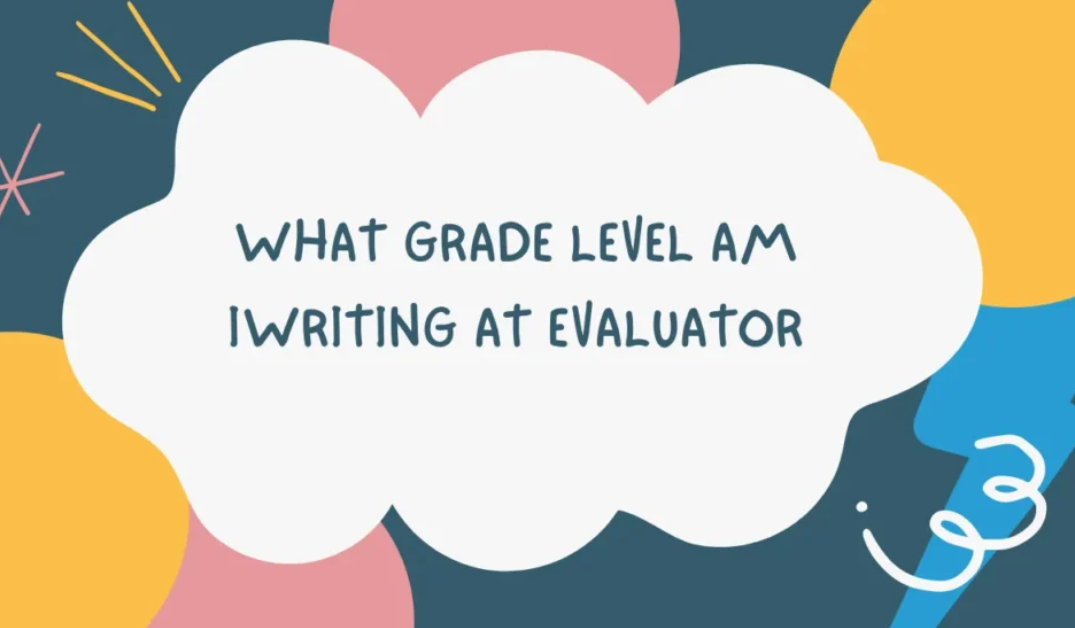A “What Grade Level am I Writing at” evaluator is a tool that checks the readability of your writing by analyzing its complexity and structure. This tool assigns a grade level to indicate how easy or difficult the text is to understand for the intended audience. For example, a text that scores at a 5th-grade level is written in a way that a 5th-grade student could easily comprehend.
These tools are commonly used by writers, educators, and businesses to ensure their writing is suitable for their target readers. By using a grade-level evaluator, you can adjust your writing to be clearer, more accessible, and appropriate for your audience, whether you’re targeting children, teenagers, or adults.
How Does a “What Grade Level am I Writing at” Evaluator Work?
A grade-level evaluator works by analyzing the structure of your writing, focusing on sentence length, word complexity, and the number of syllables in each word. Several formulas are used to calculate the grade level, with the most common being the Flesch-Kincaid Grade Level. This formula measures readability by considering both the number of syllables per word and the average sentence length. Generally, longer sentences and more syllables result in a higher grade level.
Another popular method is the Gunning Fog Index, which assesses how many complex words (words with three or more syllables) are used and the average sentence length to determine the grade level. Additional evaluators like the SMOG Index and Coleman-Liau Index also measure readability by looking at different aspects of sentence structure and word difficulty.
Once analyzed, the tool will give you a grade-level score. For example, if your text is rated at a 7th-grade level, it means the average 7th grader would be able to understand the content. This helps you tailor your writing to better suit the reading abilities of your intended audience.
Why Is a “What Grade Level am I Writing at” Evaluator Important?
Using a grade-level evaluator is important because it ensures that your writing aligns with your readers’ comprehension levels. If your text is too complex, your audience may struggle to understand your message. Conversely, if your writing is too simple, it might not engage readers who expect more sophisticated content.
For example, if you’re writing for a young audience or people learning English, it’s essential that your writing be easy to read. An evaluator provides a clear reading level score, allowing you to adjust your language accordingly to match the needs of your readers.
For professionals writing for an academic or business audience, the evaluator helps ensure that the content meets the expected level of complexity without being overly difficult. This balance is key to maintaining clarity while still sounding professional.
Who Can Benefit from Using a “What Grade Level am I Writing at” Evaluator?
Many groups of people can benefit from using a grade-level evaluator, including students, teachers, authors, and business professionals.
1. Students:
Students can use a grade-level evaluator to check their essays, reports, or assignments to make sure they are written at an appropriate level for their grade. If the evaluator suggests that the writing is too advanced, students can simplify their sentence structure and vocabulary to improve readability. This is especially helpful for those who may struggle with writing or for students who are learning English as a second language.
2. Teachers:
Teachers can use the evaluator to ensure that the reading materials they prepare, such as worksheets or book selections, are suitable for their students. By evaluating the grade level of texts, teachers can avoid overwhelming students with materials that are too difficult while still providing a challenge that encourages learning.
3. Authors:
Authors writing for specific audiences, such as children’s books or articles for different age groups, can benefit from using the evaluator. For example, if an author is writing a children’s book, the evaluator ensures that the language is accessible to young readers. For more mature audiences, authors can use the tool to confirm that the content is appropriately complex and engaging.
4. Business Professionals:
Professionals can use the evaluator to ensure their reports, presentations, or emails are clear and easy to understand. Writing that is too complex can cause confusion, while writing that is too simple might seem unprofessional. A grade-level evaluator helps find the right balance, ensuring effective communication.
How Can You Use a “What Grade Level am I Writing at” Evaluator?
Using a grade-level evaluator is straightforward and typically involves the following steps:
- Copy Your Text: Start by copying the text you want to evaluate, such as an essay, report, or email.
- Paste the Text into the Tool: Go to the grade-level evaluator tool and paste your text into the input box.
- Run the Evaluation: Click the button to start the analysis. The tool will scan your text and calculate the grade level based on sentence structure, word complexity, and syllables.
- Review the Results: After a few seconds, the evaluator will display a grade level for your text. The results may also include tips for simplifying or improving readability.
- Make Adjustments: If the grade level is too high, try using shorter sentences and simpler words. If it’s too low, consider adding more detail or advanced vocabulary.
- Reevaluate Your Writing: After making adjustments, run the tool again to check if your changes improved the readability.
What Are Some Popular “What Grade Level am I Writing at” Evaluators?
Several widely used tools help writers assess the readability of their text. Here are some of the most common:
- Flesch-Kincaid Grade Level: This tool focuses on sentence length and syllable count to calculate readability, making it a standard choice for many writers.
- Gunning Fog Index: This index measures the number of complex words and sentence length to provide a grade-level score.
- SMOG Index: This tool assesses readability based on the number of polysyllabic words (words with three or more syllables) in the text.
- Coleman-Liau Index: Unlike other tools, this index uses the number of characters in each word rather than syllables to determine readability.
These tools offer quick, effective ways to evaluate and adjust your writing.
What Are the Pros and Cons of a “What Grade Level am I Writing at” Evaluator?
Pros:
- Ensures writing matches the target audience: Helps writers tailor their language to the appropriate grade level.
- Easy to use: These tools are simple to access and provide instant results.
- Works for various writing styles: Can be used for different types of writing, from academic to business communication.
- Improves readability: Helps simplify or enhance text to improve clarity and engagement.
Cons:
- Does not assess content quality: The tool only focuses on technical aspects like sentence length and word complexity, not the quality or depth of the content.
- May not account for nuanced writing: Creative or highly technical writing may require more than a basic readability score to be fully understood.
- Requires human judgment: While the tool offers helpful feedback, a writer must still review the results and make thoughtful adjustments.
How Can a “What Grade Level am I Writing at” Evaluator Help Improve Writing Skills?
A grade-level evaluator is an excellent tool for improving writing skills over time. By regularly checking your writing with this tool, you can become more aware of how sentence structure and word choice affect readability. This awareness helps you write more clearly and effectively, regardless of your audience.
A practical way to use the evaluator is to experiment with different pieces of writing. Try submitting various drafts to see how changing sentence length or vocabulary impacts the grade level. By doing this, you’ll gain a better understanding of how to adjust your writing to meet different readability standards.
Conclusion
A “What Grade Level am I Writing at” evaluator is an invaluable tool for writers of all types. Whether you’re a student, teacher, author, or business professional, this tool helps ensure that your writing is suitable for your audience. By providing a quick assessment of your text’s readability, you can make adjustments that improve clarity, engagement, and overall effectiveness. The result is writing that communicates more clearly and reaches its intended audience more effectively.










